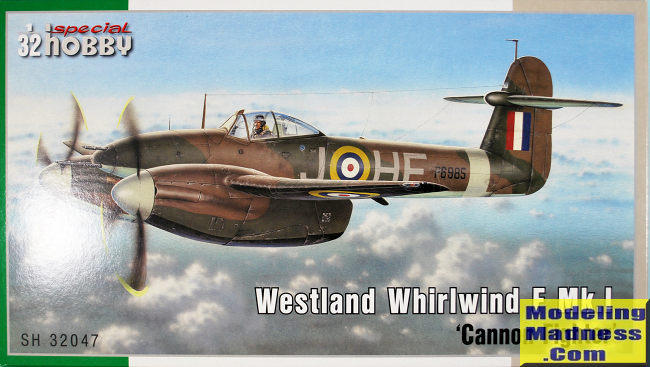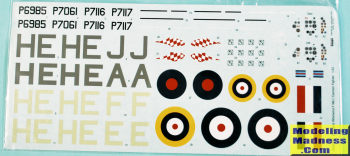
Special Hobby 1/32 Whirlwind F.1
| KIT #: | SH32047 |
| PRICE: | $71.99 |
| DECALS: | Four options |
| REVIEWER: | Tom Cleaver |
| NOTES: | 2021 tooling |

| HISTORY |
The Westland Whirlwind was, at the time of its initial appearance, one of the most advanced fighter aircraft ever built. Unfortunately, it was built to an official specification that was inherently limited, most definitely by the choice of the thoroughly second-rate Rolls-Royce Peregrine engine for its powerplant; the problems of the Peregrine had a great deal to do with why the Whirlwind was not available in numbers for the battle it was designed for - the Battle of Britain - and there was no likelihood of Rolls-Royce being able to devote the engineering time and talent necessary to make it right in the light of the demand for the far superior Merlin. By the time the idea of powering the Whirlwind with the Merlin was brought up, the design of the aircraft had been superseded. Thus, the aircraft was never able to live up to the hope expressed in its initial design.
That said, within its restrictions of size and powerplant, the Whirlwind was a very good fighter. Below 10,000 feet, a competent pilot could take on the German Bf-109 with confidence, and with the then-stunning centerline armament of four 20mm cannon, there was very little in the way of potential targets that could survive a burst of fire.
The Whirlwind came into existence as a result of Air Ministry Specification F.37/35, issued in 1935, a time when the standard RAF fighter carried two rifle-caliber machine guns and was nothing more than incrementally improved over what had flown on the Western Front 20 years earlier. The airplane that resulted from the specification was revolutionary: the first single-seat, twin engine, cannon-armed fighter to be produced and used operationally by any air force.
Design work began in 1936 under the leadership of the legendary W.E.W. Petter - who would go on to design the Canberra - and the Westland design beat submissions by both Bristol and Hawkers, with an order for two prototypes placed in February 1937. The first prototype, L6844, was flown by Westland chief test pilot Harald Penrose at Yeovil on October 11, 1938, and it rapidly proved itself faster at low altitude than any other fighter then in existence.
The twin-engine configuration was chosen because there was not an engine of sufficient power on its own to provide the necessary speed while carrying the never-before-heard-of armament of 4 20mm cannon; additionally, the layout allowed this heavy armament to be placed directly on the centerline, providing a concentration of firepower of 600 lbs/min, which would not be equalled by another fighter until the appearance of the Bristol Beaufighter. The pilot was provided with the first "bubble canopy" to be used by any combat aircraft, conferring excellent view in all directions.
From the flying viewpoint, the Whirlwind had excellent maneuverability and an outstanding rate of climb that suited it perfectly as a point-defense fighter in opposition to bombers. While Handley-Page slats were fitted to the outer wings, the production aircraft flew with them locked shut, since at least one crash of the test aircraft was attributable to slat failure.
After being handed over to the Royal Aircraft Establishment at Farnborough, the Whirlwind demonstrated such performance that an order for 200 was placed in January 1939, with first delivery for the following September.
In May, 1939, the still-secret fighter was demonstrated to several Members of Parliament at Northolt. In the words of one M.P., "the fastest time of the day was not put up by the Spitfire, but by a secret twin-engined machine that streaked over from the west." In fact, below 5,000 feet, the Whirlwind was 15 mph faster than the Spitfire I.
Unfortunately, Whirlwind production fell badly behind schedule, with the main culprit being the non-delivery of Peregrine engines by Rolls-Royce, due to the need on their part to increase production of the Merlin. Rather than September, 1939, the first production Whirlwind - P6966 - did not appear until May, 1940. Initially, the airplane was to equip 25 Squadron, which was then flying Blenheim IFs. Due to a change in re-equipment policy, the first Whirlwind squadron was 263, which had flown Gloster Gladiators in Norway that Spring, with the first Whirlwinds arriving on July 6, 1940.
As a picture of things to come, the first write-off of a Whirlwind with 263 Squadron ended in disaster on August 7, when Pilot Officer McDermott took off in P6966, the first production aircraft. The right main wheel burst its tire right at takeoff, though McDermott was able to get airborne. He then learned the landing gear was badly damaged; he could not land on it and could not retract it for a wheels-up landing. After baling out, the Whirlwind went 30 feet deep when it struck ground; to top things off, McDermott was mistaken as a German by the local Home Guard and made prisoner.
Due to lack of engines, 263 only had eight Whirlwinds as of October 1, 1940. 263 finally became operational on December 7, 1940, and had flown 30 sorties by the end of the month. Their first combat came on January 12, 1941, when P/O Stein and Flt. Sgt. Mason were ordered to intercept a Ju-88 returning from a raid. Stein intercepted the German bomber 40 miles southwest of the Scilly Isles and hit the Ju-88 solidly, though he could not observe a crash in the cloudy weather and was only credited with a "damaged." On February 9th, F/O Hughes and P/O Graham destroyed an Arado Ar-196 south of Dodman Point. During the first four months of 1941, 263 lost six pilots through flying accidents and three in action.
In June, the squadron began Warhead operations, which were strafing sorties against German targets in northwest France and the Low Countries, and by that August had destroyed three Ju-88s, eight Ju-87s and five Bf-109s on strafing missions, as well as sunk one E-boat. On August 7, 1941, four Whirlwinds were intercepted by 20 Bf-109s; the Whirlwinds managed to shoot down two of their attackers, in a fight in which two of the four were damaged and a third force-landed when it returned to base. 263 had demonstrated the value of the Whirlwind in low altitude operations, and that it could defend itself when necessary.
A second order for 200 Whirlwinds that had been place in October 1939 was cancelled, while the original order for 200 was reduced to 114, the last of which left the production line in January 1942.
In September, 1941, the Whirlwind equipped a second unit when 137 Squadron took three on charge. On February 12, 1942, during "The Channel Dash," 137 lost four Whirlwinds in a dog fight with 20 Bf-109s defending the German warships.
While 263 Squadron found their hunting grounds around the Brest and Cherbourg on the Cotentin Peninsula, 137 - operating from Manston - covered the Channel and Northern France. Both units became well-known for train-busting, with one pilot from 137 taking out four locomotives on one mission. Both squadrons developed night attack capability, destroying nearly half the trains they were credited with during night strafing missions.
On July 21, 1942 263 Squadron first attempted to turn the Whirlwind into a fighter-bomber, equipping one aircraft with racks for a 250-lb or 500-lb bomb outboard of each engine. The first test mission of the "Whirlibomber" took place on September 9, 1942, when eight Whirlwinds attacked four armed trawlers near Cherbourg, sinking two of them.
The Whirlwinds were finally taken off operations in the Spring of 1943, when first 137 and then 263 Squadron were re-equipped with Typhoons.
| THE KIT |
Modelers have long liked the Whirlwind. The airplane exudes power and performance in its out-of-the-ordinary design.
 Previously,
the Whirlwind was first released as a 1/72 kit by Airfix in the early 1960s; I
remember buiilding several of them. The kit was first released in 1/48 as a
multi-media vacuform by Cooper Details with an excellent resin cockpit; I built
one, still have it, and it looks good - the kit would still be a good choice if
you ran across one. In around 2002-03, Classic Airframes released a limited-run
injection-molded kit, which used the Cooper Details resin cockpit and vacuform
canopy; this was later re-released with a plastic canopy, and is considered one
of CA’s better kits. Trumpeter released a mainstream injection-molded kit a few
years ago which is not one of their better efforts.
Previously,
the Whirlwind was first released as a 1/72 kit by Airfix in the early 1960s; I
remember buiilding several of them. The kit was first released in 1/48 as a
multi-media vacuform by Cooper Details with an excellent resin cockpit; I built
one, still have it, and it looks good - the kit would still be a good choice if
you ran across one. In around 2002-03, Classic Airframes released a limited-run
injection-molded kit, which used the Cooper Details resin cockpit and vacuform
canopy; this was later re-released with a plastic canopy, and is considered one
of CA’s better kits. Trumpeter released a mainstream injection-molded kit a few
years ago which is not one of their better efforts.
 Special
Hobby announced they were doing the Whirlwind in 1/32 two years ago. The kit was
delayed by The Past Godawful Year, and has now been released.
Special
Hobby announced they were doing the Whirlwind in 1/32 two years ago. The kit was
delayed by The Past Godawful Year, and has now been released.
This is without a doubt the best kit of the
Whirlwind released by anyone to date. The kit has beautiful surface detail with
both raised and engraved rivets and panels, all done in a very petite manner.
The cockpit is fully detailed and caters to both early and late production
details. Bombs and racks are provided for a “whirlibomber,” though none of the
four markings options would cover that role. The markings include four options,
all from 263 Squadron - two in Dark Earth/Dark Green/Sky, and two in Mixed
Grey/Dark Green/Sea Grey Medium; all come from the 1941-early 1942 period by the
insignia. The two-piece canopy ha s
a windscreen molded integral with the surrounding fuselage, which will guarantee
no gaps. The kit does not include any photoetch and a modeler will have to
source seatbelts in aftermarket.
s
a windscreen molded integral with the surrounding fuselage, which will guarantee
no gaps. The kit does not include any photoetch and a modeler will have to
source seatbelts in aftermarket.
Special Hobby will obviously release other options - airplanes from 137 Squadron, Whirlibombers, etc., as they always do to maximize the life of the molds.
The kit does not appear to be difficult and is relatively simple in overall design. Test-fitting parts shows things go together nicely, so a minimum of filler will be needed.
Highly recommended to Whirlwind fans. This goes to the top of the To-Do pile.
May 2021
Copyright ModelingMadness.com. All rights reserved. No reproduction without express permission.
If you would like your product reviewed fairly and fairly quickly, please contact the editor or see other details in the Note to Contributors.